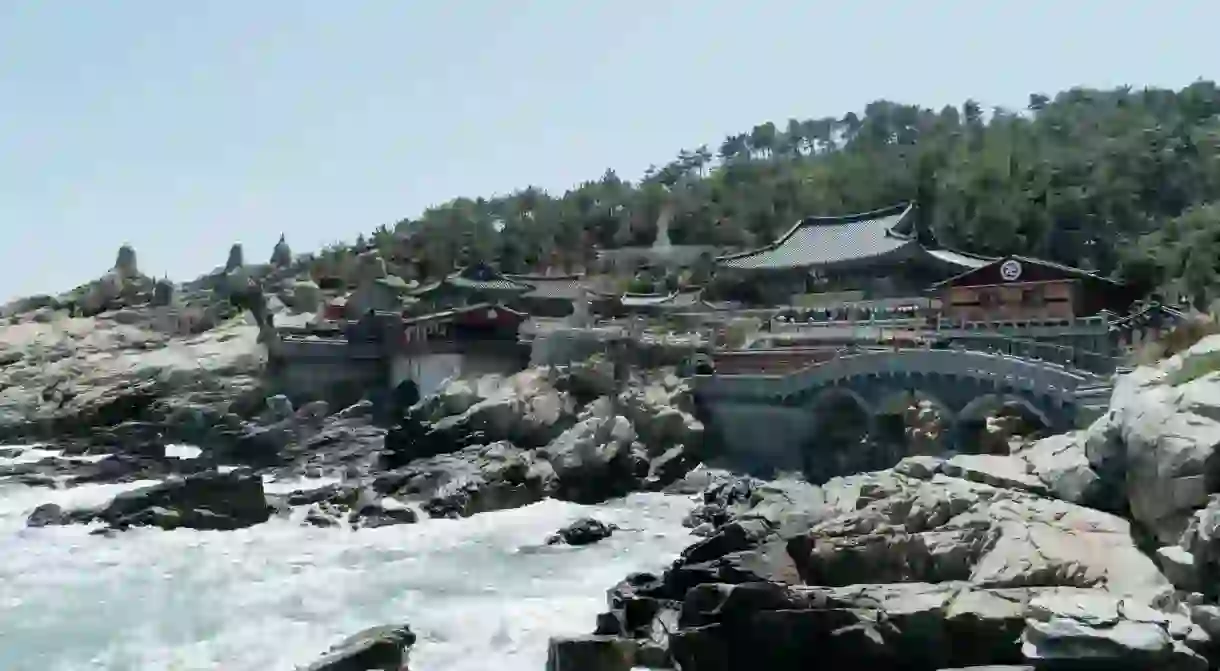A Brief History of Haedong Yonggungsa Temple

As one of the only oceanside Buddhist temples in all of South Korea, Haedong Yonggungsa is also one of the country’s most unique places of worship. With more than 600 years of history, the temple is known for its unusual location and mystical occurrences. Join us as we explore its roots.
A dream come true
Nestled on a beautiful stretch of cliffy coastline in northeastern Busan, Haedong Yonggungsa dates back to as early as 1376 when it was founded by Naong Hyegeun (1320–1376), a royal consultant during the Goryeo Dynasty (918-1392) and a great Master who helped lay the foundation for Buddhism in the Joseon era (1392-1910).
It is said that while Naong was practicing asceticism at Bunhwangsa Temple in Gyeongju, the kingdom that is now present-day Korea was plagued by a drought that resulted in the destruction of crops and subsequent famine. Angry at the gods for not providing rain, people began to reject Buddhism, which had already been waning in popularity due to the corruption that was rampant in the religion at that time.
Legend has it that one day, a sea god appeared to Naong in a dream. The god told him that if he were to build a temple on the fringes of Bongrae Mountain and prayed there, people would once again live happily, without hardship.
Following the dream, Naong traveled to the site where Haedong Yonggungsa is currently located. He instantly recognized that the site was auspicious according to the principles of pungsu-jiri-seol, being situated between a mountain and the sea. Naong named the mountain Bongrae, which refers to the pure state of mind achieved by great hermits and built a temple there. The temple was later called Bomun, which denotes the absolute and limitless power of Gwanseum-bosal, the Goddess of Mercy.




Divine intervention
Like most temples in Korea, Haedong Yonggungsa was damaged and rebuilt over the years. During the early Japanese invasions of Korea (1592–1598), also called the Imjin War, the temple was nearly destroyed by a fire, falling into ruin, where it remained for many years.
It was only in the early 1930s that the monk Ungang of Tongdosa Temple began to reconstruct the complex. Following his initial efforts, Ungang’s fellow monks took great care to restore and care for the temple.
In 1974, when the temple’s newly-appointed head monk Jeong-am was practicing jeong-geon kido – 100 days of intensive prayers – he had a vision. The apparition that appeared to him was none other than the Goddess of Mercy herself, cloaked in a white gown riding on the back of a dragon emanating a multicolor beam of light. It was then that Jeong-am renamed the temple Haedong Yonggungsa, meaning Korean Dragon Palace Temple.


Spirituality by the sea
Today, Haedong Yonggungsa continues to preserve its unique religious traditions as well as its harmony with nature, and is one of three temples devoted to the Goddess of Mercy.
The complex is centered around the Daeungjeon Main Sanctuary, which was restored in 1970 with great attention paid to the colors that were used on its exterior. In front of the sanctum is a magnificent three-story pagoda that is guarded by four stone lions symbolizing joy, anger, sadness, and happiness.
Nearby is the Yacksayeorae Healing Buddha, a gat (traditional Korean hat)-wearing Buddha statue that is believed to cure diseases, in addition to a path of 108 stairs and stone lanterns that snakes through the temple.
Perhaps the most noteworthy site of Haedong Yonggungsa is the Haesu Gwaneum Daebul, or statue of the Goddess of Mercy. It’s said that this structure is particularly mystical, as snow has never settled heavily here and that even in winter, arrow root flowers grow around it. In addition, a bright, five-color light (much like the one seen by Jeong-am) mysteriously spotlighted the statue on the third day following its enshrinement.
These enigmatic occurrences, along with Haedong Yonggungsa’s history, architectural beauty and stunning ocean views continue to make it one of the most popular temples in South Korea, attracting visitors from all over the world seeking a bit of spiritual intervention.













